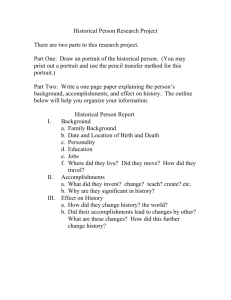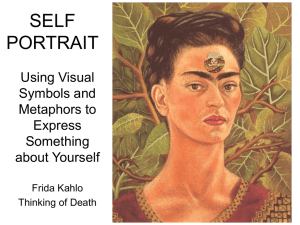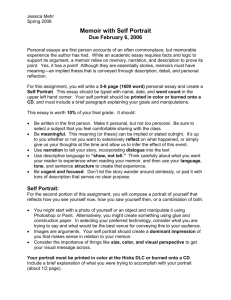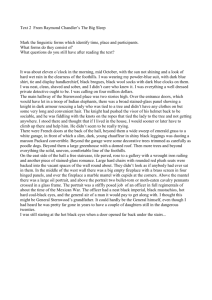expert`s statement
advertisement
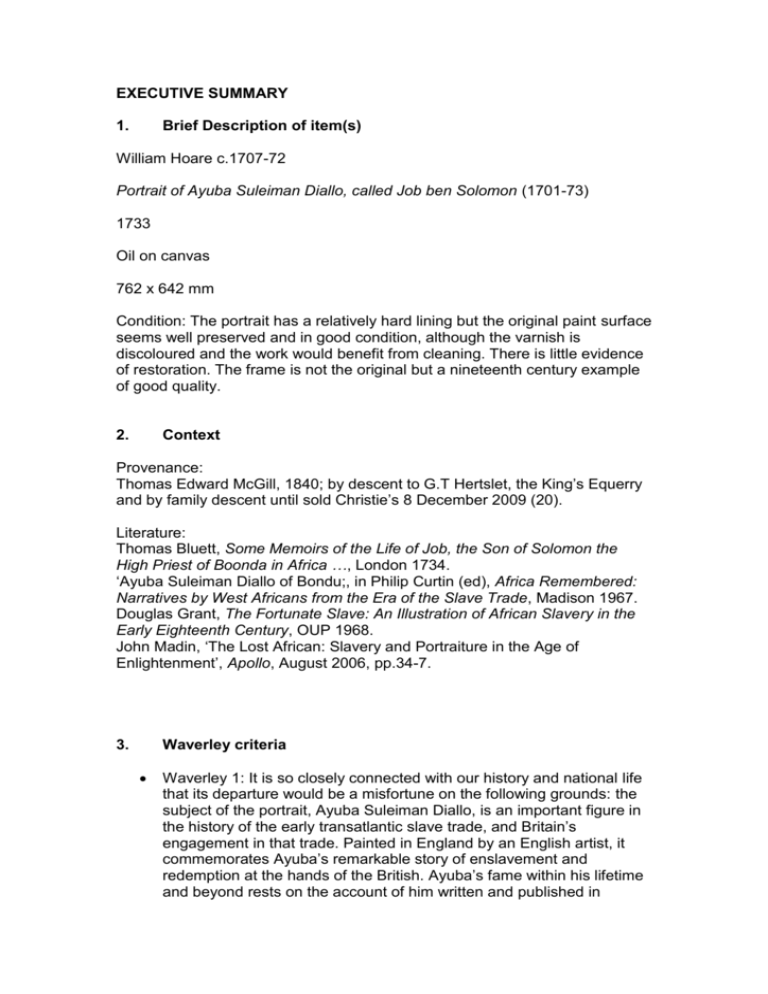
EXECUTIVE SUMMARY 1. Brief Description of item(s) William Hoare c.1707-72 Portrait of Ayuba Suleiman Diallo, called Job ben Solomon (1701-73) 1733 Oil on canvas 762 x 642 mm Condition: The portrait has a relatively hard lining but the original paint surface seems well preserved and in good condition, although the varnish is discoloured and the work would benefit from cleaning. There is little evidence of restoration. The frame is not the original but a nineteenth century example of good quality. 2. Context Provenance: Thomas Edward McGill, 1840; by descent to G.T Hertslet, the King’s Equerry and by family descent until sold Christie’s 8 December 2009 (20). Literature: Thomas Bluett, Some Memoirs of the Life of Job, the Son of Solomon the High Priest of Boonda in Africa …, London 1734. ‘Ayuba Suleiman Diallo of Bondu;, in Philip Curtin (ed), Africa Remembered: Narratives by West Africans from the Era of the Slave Trade, Madison 1967. Douglas Grant, The Fortunate Slave: An Illustration of African Slavery in the Early Eighteenth Century, OUP 1968. John Madin, ‘The Lost African: Slavery and Portraiture in the Age of Enlightenment’, Apollo, August 2006, pp.34-7. 3. Waverley criteria Waverley 1: It is so closely connected with our history and national life that its departure would be a misfortune on the following grounds: the subject of the portrait, Ayuba Suleiman Diallo, is an important figure in the history of the early transatlantic slave trade, and Britain’s engagement in that trade. Painted in England by an English artist, it commemorates Ayuba’s remarkable story of enslavement and redemption at the hands of the British. Ayuba’s fame within his lifetime and beyond rests on the account of him written and published in London in 1734. Ayuba figures prominently in abolitionist arguments, and his visit to Britain had a profound impact on Britain’s understanding of West African culture, identity and religion. Waverley 3: It qualifies as of outstanding significance for the study of some particular branch of art, learning or history through its status as the first British painting of a freed slave so far identified; and also the earliest portrait so far uncovered of a named West African visitor to Britain, presented as an individual and as an equal. As such, it is of prime importance for the history of the development of non-European portraiture in Britain, and the study of evolving responses within Britain to other cultures. DETAILED CASE 1. Detailed description of item(s) if more than in Executive summary, and any comments. The sitter of this portrait, Ayuba Suleiman Diallo, or Job ben Solomon as he was known in England, is a significant and substantial figure in the history of the early eighteenth century transatlantic slave trade. Born to a powerful family of Muslim clerics of the Fulbe tribe in the Bondu region of Senegambia, Ayuba was a high-status, educated and wealthy individual who, as well as his native language, spoke, wrote and read Arabic. At the age of 29, while on a trading mission to sell slaves and to buy paper and cattle, Ayuba was himself taken into captivity, enslaved and transported to Maryland on the Arabella, a Royal African Company merchant ship of London. Put to work on a tobacco plantation, he was imprisoned for escaping but came to the attention of the English lawyer, Thomas Bluett, who, through Ayuba’s ‘affable Carriage’ and the ‘easy Composure of his Countenance’, perceived he was ‘no common Slave’. Ayuba was taken to London in 1733 and released from slavery through money raised by public subscription. He lodged for a while with Bluett in Cheshunt, Hertfordshire, where he was popular among the local gentry, and then at Africa House in the City, at the expense of the Royal African Company. While in London Ayuba enjoyed celebrity status, mixing with aristocrats such as the Dukes of Portland and Montagu, who arranged for his presentation at Court in a ‘rich silk Dress, made up after his own Country Fashion’. He translated Arabic manuscripts and inscriptions on medals for Sir Hans Sloane, and made transcriptions of the Qu’ran which are still preserved at Oxford. Ayuba’s portrait was commissioned by his circle of supporters. The event, and Ayuba’s reaction to the request, is recorded in Thomas Bluett’s account of Ayuba’s experiences, Some Memoirs of the Life of Job … , published in London in 1734, the year Ayuba returned to Africa: ‘Job’s Aversion to Pictures of all Sorts was exceeding great’, writes Bluett, ‘insomuch that it was with great Difficulty that he could be brought to sit for his own. We assured him that we never worshipped any Picture, and that we wanted his for no other End but to keep us in mind of him. At last he consented to have it drawn; which it was done by Mr Hoare. When the Face was finished, Mr Hoare ask’d what Dress would be most proper to draw him in; and, upon Job’s desiring to be drawn in his own Country Dress, told him he could not draw it, unless he had seen it, or had it described to him by one who had; Upon which Job answered, If you can’t draw a Dress you never saw, why do some of your Painters presume to draw God’. This portrait is presumably the original portrait by Hoare mentioned in Bluett’s Memoirs which until its appearance on the art market in 2009 was believed lost and known only through Bluett’s description of the sitting and the engravings made after it (in 1734, published as the frontispiece to the Memoirs; and another, published in the Gentleman’s Magazine in June 1750). The portrait is not signed but carries identifying inscriptions on the reverse (on the lining ‘PORTRAIT OF / JOB:BEN:SOLOMON.’ and on the stretcher ‘PAINTED BY WILLIAM HOARE OF BATH IN 1733’). Ayuba appears in his native dress, in a turban and with a copy of the Qu’ran hanging round his neck, which proudly identifies him as a Muslim. The portrait’s re-emergence has inadvertently cast light on the career of William Hoare, a leading portraitist and a founding member of the Royal Academy but who was thought to have been travelling in Italy from 1728 to 1737. In fact, Hoare is recorded in Italy only until 1732, and the date of this portrait firmly places him in England by 1733/4. But the major significance and importance of this portrait lies in the identity of the sitter, not the artist. Not only is it an image of a noted individual of true importance to the early history of the transatlantic slave trade, but it also appears to be the earliest depiction of a named West African to have been painted in Britain. Ayuba is presented as an individual and as a gentleman, and from Bluett’s account we know that the stimulus for the commission was to commemorate a friendship and an extraordinary visit. Such portraits of West Africans in Britain are rare, and other noted examples are all later. Francis Williams, by an unknown artist, is dated c.1745 (V&A); William Ansah Sessarakoo is only known through John Faber’s mezzotint after Gabriel Mathias of c.1750; the well known Portrait of an African, formerly identified as Olaudah Equiano but now thought to be Ignatius Sancho and attributed to Allan Ramsay, is dated c.1758; and Gainsborough’s image of the same sitter (National Gallery, Canada) is also later. Of these, Ayuba is the only one to be shown in his native, opposed to Western European, dress, allowing him a confident and proud identity. 2. Detailed explanation of the outstanding significance of the item(s). As outlined in part 1, Ayuba Suleiman Diallo is a figure of major importance in in Britain’s slaving history. Bluett’s published Memoirs is central to discussions of early slave narratives, for which it is a much cited and key text. Bluett’s description of Ayuba’s character, together with this portrait which Bluett and his friends commissioned, act as important evidence for the evolving, changing and increasingly enlightened attitude to black people in Britain in the eighteenth century. Throughout his Memoirs, Bluett portrays Ayuba as an admirable character. He stresses his dedication to Islam, his learning, good nature, charm and wit, and his skill at reasoned argument. Ayuba’s portrait reinforces this positive attitude in its depiction of Ayuba as a dignified individual, who retains his native dress and openly displays his Islamic faith, and is shown as a gentleman and an equal, and within the conventions of polite portraiture. Ayuba’s story of capture and survival, freedom and celebrity and safe return to Africa, was brought to the world through the writings of Englishmen, chiefly Thomas Bluett’s Memoirs, published in London in 1734, and also Francis Moore’s Travels into the Inland Parts of Africa, published in London in 1738 (Moore was a Royal African Company official who knew Ayuba on his return to Senegambia in 1734). Both works went through several editions and were translated into French, ensuring Ayuba’s continued fame. Bluett’s account is seen as an important early precursor to the major slave narratives of the later eighteenth century and, like them, was influential in shaping British attitudes and moral opinions towards slavery. Although ironically a slaveowner himself, Ayuba became for English abolitionists a highly important example of an African who possessed admirable human qualities, which furthered the argument for Africans as men of feeling deserving of humanity. There is no doubt that Ayuba’s presence in England, and the accounts of his experience, had a great impact in Britain both at the time and later. Although his English friends and liberators were open-minded and compassionate in their attitude towards him, nevertheless their outlook was shaped by the times they lived in. Ayuba’s story is presented by Bluett as one of redemption through divine providence – Ayuba gained redemption through the providence of God and the moral actions of those around him. Despite accepting and admiring Ayuba’s adherence to his faith, Bluett recounts engaging him in religious debate and presenting him with an Arabic translation of the New Testament (most likely the leading Orientalist George Sale’s, who translated it for the Society for the Promotion of Christian Knowledge for circulation in the Ottoman Empire and in Africa) in an attempt to sway him. It was a time in which, for Englishmen, Christianity, and Protestantism, were predominant, as was the empirical desire to convert. Yet the early eighteenth century was also a time of academic study of Islam: Ayuba’s release from slavery and return to Africa by the Royal African Company in 1734 was also the date of Sale’s translation of the Qu’ran into English. Whether Sale met Ayuba in London, as a scholar of Islam, is unknown. Ayuba’s return to Africa also came at precisely the time that the Royal African Company, whose main trading commodities had been salves and gold, was easing its trade in slaves and looking for other markets. It was the Company’s expectation that, in exchange for his redemption and generous treatment by the English, Ayuba would work to further British interests in Africa, especially in the gum trade. Ayuba’s story is therefore significant for contemporary debates about the nature of Islam, the work of colonial Christian missionaries, and English commercial interests. As demonstrated in part 1, Ayuba’s portrait is an important early, if not the earliest, depiction of a named West African to have been painted in England; it appears to be the first British painting of a freed slave; and it is also an interesting and important image of a Muslim. Black people and Muslims were present in England from the sixteenth century, but early portraits of named individuals are rare. Young black slaves appear as accessories and symbols of wealth and status in the background of seventeenth-century portraits of the aristocratic and wealthy; they appear as a ‘living ethnography’, representing habits and costume, in travel literature and associated images; and there was a tradition of painting resident North African Ambassadors, the earliest being Abdel-Ouahed ben Messaoud Anoun, c.1600 (Birmingham), and others were painted by Sir Godferey Kneller in the period 1684-1715. The latter, however, were created within the tradition of court-commissioned diplomacy. This privately commissioned portrait of a black visitor to England, allowed the dignity of his own native dress and the social status of an equal, is a highly important image in the history of the development of the iconography of nonEuropean portraiture in Britain. Conlusion Ayuba’s high social status in his homeland, rather than his education, intellect and good character, was the reason that his freedom became possible. In the history of the slave trade his story is therefore unusual and exceptional, yet the dissemination of his narrative by various authors during the eighteenth century ensured that his story made a lasting impact on abolitionists and played an important role in the development of enlightened attitudes towards black people and their moral rights. Ayuba’s narrative still plays a central part today in scholarship surrounding slavery. His enthusiastic and positive reception in England, where he was admired for his religious devotion, moral qualities and intellect, and was treated as a social equal, is reflected in this portrait which is of significance for the development of non-European portraiture in Britain. This portrait of him, painted by an English artist in England at the behest of his English friends to commemorate his extraordinary journey, is a highly significant and potent image of a famous individual connected to the British transatlantic slave trade. The latter is a history which was given added focus in 2007, with exhibitions and museum displays around the country marking the 1807 abolition. As a portrait of a Muslim, a West African and a freed slave who holds an important place in British history, in multi-cultural Britain this portrait has a powerful resonance. Tabitha Barber, Tate Britain 19/2/2010


